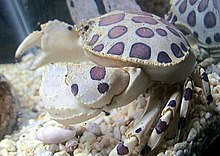Hepatus epheliticus, known by various names, including the calico crab (not to be confused with Ovalipes ocellatus) and Dolly Varden crab, is a species of crab. It lives in shallow water in the western Atlantic Ocean from the Chesapeake Bay to the Dominican Republic. It has a 3-inch (76 mm)–wide carapace adorned with large red spots with darker outlines.
| Hepatus epheliticus | |
|---|---|

| |
| Scientific classification | |
| Kingdom: | |
| Phylum: | |
| Subphylum: | |
| Class: | |
| Order: | |
| Infraorder: | |
| Family: | |
| Genus: | |
| Species: | H. epheliticus
|
| Binomial name | |
| Hepatus epheliticus | |
| Synonyms [1] | |
| |
Description edit
H. epheliticus grows to 3 inches (76 mm) across the carapace,[2] which is covered in large patches of red color, which may join up into lines or other patterns.[3] The spots are outlined in a darker color; in some crabs, only the darker rings are visible.[4]
Distribution edit
The range of H. epheliticus extends from the Chesapeake Bay southwards, including the whole of the Gulf of Mexico, and as far south as Jamaica and the Dominican Republic.[3]
Ecology and life cycle edit
H. epheliticus lives at depths of up to 46 m (151 ft) on sandy and muddy substrates.[3] It often carries the sea anemone Calliactis tricolor on its back,[5] or lies buried in the sand, with only its eyes exposed.[6]
Reproduction occurs in summer, as shown by the occurrence of "berried" (egg-bearing) females.[5] The eggs are held by the female until they hatch; there are five planktonic zoea stages.[7]
Taxonomy edit
H. epheliticus was first described, under the name Cancer epheliticus, by Carl Linnaeus in his 1763 work Centuria Insectorum,[8] based on specimens from Carolina sent to him by Alexander Garden.[9] Subjective synonyms of H. epheliticus include Cancer decorus, published by Johann Friedrich Wilhelm Herbst in 1803, and Cancer vanbenedenii, published by Jan Adrian (or Janus Adrianus) Herklots in 1852.[1]
H. epheliticus is known by several common names, including calico box crab,[3] calico crab,[4] Gulf calico crab,[6] and Dolly Varden crab.[4]
References edit
- ^ a b Peter K. L. Ng; Danièle Guinot & Peter J. F. Davie (2008). "Systema Brachyurorum: Part I. An annotated checklist of extant Brachyuran crabs of the world" (PDF). Raffles Bulletin of Zoology. 17: 1–286. Archived from the original (PDF) on 2011-06-06.
- ^ Edward E. Ruppert & Richard S. Fox (1988). "Box crabs". Seashore animals of the Southeast: a guide to common shallow-water invertebrates of the southeastern Atlantic Coast. University of South Carolina Press. pp. 252–253. ISBN 978-0-87249-535-7.
- ^ a b c d Harriet Perry & Kirsten Larsen (April 2, 2004). "A Picture Guide to Shelf Invertebrates from the Northern Gulf of Mexico" (PDF). Retrieved June 17, 2010.
- ^ a b c Gilbert L. Voss (2002). "Calico crab, Dolly Varden crab". Seashore Life of Florida and the Caribbean. Dover pictorial archive series. Courier Dover Publications. pp. 98. ISBN 978-0-486-42068-4.
- ^ a b Susan B. Rothschild (2004). "Crabs". Beachcomber's Guide to Gulf Coast Marine Life: Texas, Louisiana, Mississippi, Alabama, and Florida (3rd ed.). Taylor Trade Publications. pp. 30–31. ISBN 978-1-58979-061-2.
- ^ a b Eugene H. Kaplan (1999). A Field Guide to Southeastern and Caribbean Seashores: Cape Hatteras to the Gulf Coast, Florida, and the Caribbean. Peterson Field Guides (2nd ed.). Houghton Mifflin Harcourt. ISBN 978-0-395-97516-9.
- ^ Maria L. Negreiros-Fransozo; Adilson Fransozo & Gustavo L. Hirose (2008). "The megalopa and early juvenile development of Hepatus pudibundus (Crustacea: Brachyura: Aethroidea) reared from neuston samples". Revista Brasileira de Zoologia. 25 (4): 608–616. doi:10.1590/S0101-81752008000400005. hdl:11449/19286.
- ^ Gilberto Rodriguez (1993). "From Oviedo to Rathbun: The development of brachyuran crab taxonomy in the Neotropics (1535–1937)". In Frank Truesdale (ed.). History of carcinology. Volume 8 of Crustacean Issues. CRC Press. pp. 41–73. ISBN 978-90-5410-137-6.
- ^ Carl Linnaeus (1763). Centuria Insectorum Rariorum (PDF) (in Latin). Uppsala. Archived from the original (PDF) on 2011-07-28.
External links edit
- Media related to Hepatus epheliticus at Wikimedia Commons